- Tips for Autumn Pruning of Fruit Trees
- 1. Choose the Right Tools
- 2. Remove Dead and Diseased Wood
- 3. Thin Out Overcrowded Branches
- 4. Prune for Shape and Structure
- 5. Consider the Type of Fruit Tree
- 6. Timing is Key
- 7. Dispose of Pruned Material Properly
- Proper Tools for Pruning
- Reasons for Autumn Pruning
- Key Techniques of Pruning
- Pruning Timing for Different Fruit Trees
- Apple Trees
- Peach Trees
- Plum Trees
- Cherry Trees
- Pear Trees
- Apricot Trees
- Pruning Young Fruit Trees
- 1. Start Early
- 2. Train the Central Leader
- 3. Remove Weak or Diseased Branches
- 4. Encourage Branch Spacing
- 5. Consider the Tree’s Form
- 6. Don’t Overprune
- 7. Timing
- Pruning Mature Fruit Trees
- 1. Timing
- 2. Tools
- 3. Techniques
- 4. Aftercare
- Pruning Diseased or Damaged Branches
- 1. Identify the diseased or damaged branches
- 2. Gather the necessary tools
- 3. Remove the diseased or damaged branches
- 4. Dispose of the removed branches
- 5. Take preventive measures
- 6. Consider professional help
- Aftercare and Maintenance
- 1. Mulch
- 2. Watering
- 3. Fertilizing
- 4. Pest and Disease Control
- 5. Training and Support
- 6. Regular Maintenance
- 7. Record Keeping
- Question-answer:
- When is the best time to prune fruit trees in autumn?
- Why is autumn pruning important for fruit trees?
- What are some tips for pruning fruit trees in autumn?
- Can I prune my fruit trees in autumn if they are still producing fruit?
- How long does it take for a pruned fruit tree to recover?
- Video: Summer Pruning for Young Fruit Trees
As the crisp autumn air sets in, it’s time to turn our attention to the care of fruit trees. One of the most important tasks for fruit tree owners is pruning. Autumn pruning plays a vital role in shaping the tree, promoting healthy growth, and ensuring abundant fruit production in the following season.
Pruning fruit trees in the autumn is different from winter or summer pruning. It’s a delicate balance between removing dead or damaged branches and giving the tree an opportunity to heal before the colder months set in. Autumn pruning encourages the tree to redirect its energy towards root development, helping it anchor itself and store nutrients for the coming winter.
When it comes to techniques, there are a few key considerations. First, it’s important to remove any dead or diseased wood, as these can harbor pests and diseases that can spread to the rest of the tree. It’s best to make clean, angled cuts just outside the branch collar, as this will minimize the risk of infection and aid in the healing process.
Timing is also crucial when it comes to autumn pruning. It’s recommended to prune fruit trees after the harvest season and before the first frost. This allows the tree to recover from the stress of fruit production and minimizes the risk of cold damage to the freshly pruned branches. By timing the pruning correctly, you’ll give your fruit trees the best chance to thrive and bear bountiful fruit in the next growing season.
Tips for Autumn Pruning of Fruit Trees
Autumn is an important time to prune your fruit trees in order to promote healthy growth and improve fruit production for the following year. Here are some tips to help you make the most of your autumn pruning:
1. Choose the Right Tools
Before you start pruning, make sure you have the right tools for the job. Sharp bypass pruners, loppers, and a pruning saw are essential for different types of cuts on different size branches. Keeping your tools clean and sharp will ensure clean cuts and minimize the risk of disease.
2. Remove Dead and Diseased Wood
Begin by removing any dead or diseased wood from your fruit trees. Dead branches can be identified by their lack of buds or leaves, while diseased wood may have discoloration or lesions. Removing these branches will prevent the spread of disease and allow for new growth.
3. Thin Out Overcrowded Branches
Thinning out overcrowded branches will allow more light and air to reach the center of the tree, reducing the risk of pests and diseases. Remove any branches that are crossing or rubbing against each other and those that are growing vertically or towards the center of the tree.
4. Prune for Shape and Structure
Prune your fruit trees to maintain a balanced shape and structure. Look for outward-facing buds and make angled cuts just above them. This will encourage new growth in the desired direction and prevent the development of weak branches.
5. Consider the Type of Fruit Tree
Each type of fruit tree has its own pruning requirements. Research the specific needs of your fruit tree, as different varieties may have different growth habits and pruning techniques. Some fruit trees, like apple and pear trees, benefit from annual pruning, while others, like peach and nectarine trees, require more minimal pruning.
6. Timing is Key
Pruning should be done during the dormant period of the tree, which is usually in late autumn or winter. This allows the tree to heal properly before new growth begins in spring. Avoid pruning during periods of extreme cold or when the tree is wet, as this can increase the risk of damage and disease.
7. Dispose of Pruned Material Properly
Properly dispose of pruned material to prevent the spread of pests and diseases. Burn or dispose of diseased wood, and consider chipping or composting healthy branches and twigs. Avoid leaving pruned material on the ground near the tree.
Following these tips will help you ensure the health and productivity of your fruit trees. Happy pruning!
Proper Tools for Pruning
Using the right tools for pruning is essential to ensure clean and precise cuts, as well as to prevent damage to the tree. Below are some of the most important tools for pruning fruit trees:
- Pruning Shears: Also known as hand pruners, these are designed for cutting small branches and twigs. Look for a pair with sharp blades and comfortable handles.
- Loppers: Loppers have long handles and can handle branches up to 2 inches in diameter. They are ideal for cutting thicker branches with ease.
- Pruning Saw: A pruning saw is used for cutting larger branches that cannot be easily cut with shears or loppers. Look for a saw with a curved or straight blade, depending on your preference.
- Pole Pruner: If you have tall fruit trees, a pole pruner can be a valuable tool for reaching high branches. It consists of a long pole with a pruning head at the end.
- Gloves: Wearing gloves while pruning is important to protect your hands from scratches and cuts. Look for gloves that are durable and offer a good grip.
Before using any pruning tools, make sure they are clean and sharp. Dull blades can lead to messy cuts and can damage the tree. Additionally, it’s important to clean the tools after each use to prevent the spread of diseases between trees.
Investing in high-quality pruning tools is a smart choice as they will last longer and provide better results. It’s also a good idea to consult with a local gardening expert or arborist to get recommendations on the best tools for your specific fruit trees.
Reasons for Autumn Pruning
- Encourages Fruit Production: Pruning fruit trees in autumn helps stimulate new growth and encourages the production of fruit in the next growing season. By removing excess branches and dead wood, the tree can channel its energy into producing healthy and abundant fruit.
- Promotes Air Circulation: Autumn pruning allows for improved air circulation within the tree canopy, reducing the likelihood of fungal diseases such as apple scab or brown rot. Adequate air circulation helps prevent the growth and spread of harmful pathogens that can damage the fruit and tree’s overall health.
- Controls Tree Size and Shape: Pruning during autumn enables control over the size and shape of the fruit tree. By selectively removing branches, the tree can be trained to grow in a desired shape and size. Pruning can also help prevent overcrowding, ensuring that each branch receives sufficient sunlight and nutrients for optimal growth.
- Eliminates Diseased and Damaged Wood: Autumn is an ideal time to identify and remove diseased or damaged wood from fruit trees. This practice helps prevent the spread of diseases and pests, limiting their impact on the overall health of the tree. By removing affected branches, the tree has a better chance of remaining healthy and producing quality fruit.
- Improves Aesthetic Appeal: Pruning fruit trees in autumn can enhance their overall appearance, making them look more visually pleasing. By removing unwanted branches and shaping the tree, it can fit better into the landscape and contribute to the overall aesthetic appeal of the garden or orchard.
Key Techniques of Pruning
- Heading cuts: These cuts are made to remove large branches or tops of the trees. Heading cuts should be made just above a bud or lateral branch.
- Thinning cuts: Thinning cuts are made to remove smaller branches and create more space and light for the remaining branches. These cuts should be made all the way back to the main branch.
- Renewal cuts: Renewal cuts involve removing older, less productive wood to encourage the growth of new, healthy branches.
- Pruning at the right angle: When making cuts, it is important to cut at the right angle to promote proper healing and minimize the risk of disease. Cuts should be made at a slight angle, just above a bud or lateral branch.
- Creating a central leader: Fruit trees should ideally have a central leader branch, which serves as the main trunk. Pruning techniques can be used to encourage the growth of a central leader and remove competing branches.
- Managing tree height: Pruning can also be used to control the height of fruit trees, making it easier to harvest and maintain the trees. By selectively removing top growth, the height of the tree can be managed.
- Regular maintenance: Regular pruning is needed to maintain the shape and health of fruit trees. This includes removing dead, diseased, or damaged wood, as well as any branches that are crossing or rubbing against each other.
Using these key pruning techniques can help ensure the health and productivity of your fruit trees. It is important to approach pruning with caution and follow proper techniques to avoid damaging your trees.
Pruning Timing for Different Fruit Trees
Timing is crucial when it comes to pruning fruit trees. Different types of fruit trees have different optimal pruning times, and it’s important to follow the specific recommendations for each variety. Here is a general guide on when to prune some common fruit trees:
Apple Trees
- Winter Pruning: It is best to prune apple trees during late winter or early spring, before new growth begins. This timing helps prevent the spread of diseases and stimulates healthy growth.
- Summer Pruning: Some light pruning can be done during the summer to remove suckers, watersprouts, and any damaged or diseased branches. However, avoid heavy pruning during this time as it can reduce fruit production.
Peach Trees
- Winter Pruning: Peach trees are best pruned during late winter or early spring, before bud break. This allows the wounds to heal quickly before the start of the growing season.
- Summer Pruning: Minimal summer pruning is recommended for peach trees. Remove any dead or diseased wood as soon as it is noticed.
Plum Trees
- Winter Pruning: Plum trees are typically pruned in late winter or early spring, before the buds begin to swell. Pruning at this time reduces the risk of silver leaf disease.
Cherry Trees
- Winter Pruning: Cherry trees are best pruned during late winter or early spring, before new growth starts. Pruning during this time helps prevent the spread of diseases.
- Summer Pruning: It is generally advised to avoid summer pruning of cherry trees to minimize the risk of bacterial canker infection. If necessary, only prune lightly to remove suckers or water sprouts.
Pear Trees
- Winter Pruning: Pear trees should be pruned during late winter or early spring, before bud break. This timing minimizes the risk of fire blight infection.
- Summer Pruning: Some light summer pruning can be done to maintain the shape of pear trees and remove any unwanted growth. However, avoid heavy pruning during this time as it can reduce fruit production.
Apricot Trees
- Winter Pruning: Apricot trees are best pruned during late winter or early spring. Pruning during this time reduces the risk of diseases and allows the wounds to heal quickly.
Remember, these are general guidelines, and it’s always best to consult specific pruning recommendations for your particular fruit tree variety. Additionally, always use clean and sharp pruning tools to minimize damage to the trees.
Pruning Young Fruit Trees
Pruning young fruit trees is an important task that helps establish a strong and healthy tree structure, encourages fruit production, and promotes overall tree vitality. Here are some tips and techniques for pruning young fruit trees:
1. Start Early
It is best to start pruning young fruit trees in their first or second year after planting. This allows you to shape the tree from its early stages and ensures a good foundation for future growth.
2. Train the Central Leader
The central leader is the main vertical stem of the tree. It should be carefully trained by removing any competing branches that may grow taller or interfere with the tree’s structure. This will help the tree grow straight and develop a strong central leader.
3. Remove Weak or Diseased Branches
Identify and remove any weak or diseased branches during the pruning process. This helps prevent the spread of diseases and promotes the growth of healthy branches.
4. Encourage Branch Spacing
Pruning can help create proper branch spacing, which allows sunlight and air to reach all parts of the tree. This helps prevent disease and promotes even fruit development. Remove any branches that are too closely spaced or growing in the wrong direction.
5. Consider the Tree’s Form
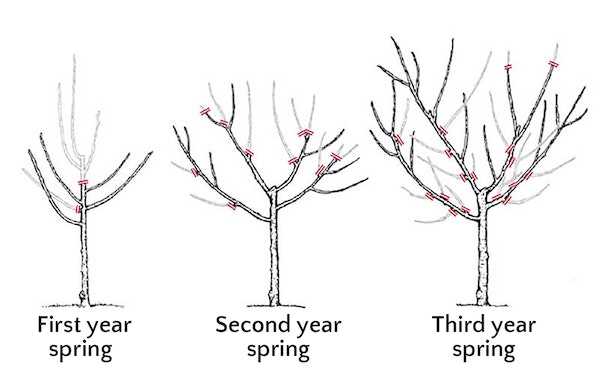
Each fruit tree has a natural form or shape. Consider the tree’s form and prune accordingly. For example, apple trees typically have a pyramid shape, while peach trees have an open vase shape. Pruning to enhance the natural form can improve the tree’s health and aesthetics.
6. Don’t Overprune
Avoid excessive pruning, especially in the early years. Overpruning can weaken the tree and delay fruit production. Prune only as necessary to maintain a balanced shape and remove any damaged or diseased branches.
7. Timing
Prune young fruit trees during late winter or early spring, before new growth begins. This allows the tree to heal quickly and minimizes the risk of disease. Avoid pruning during the dormant period in late autumn, as this can stimulate new growth that may be susceptible to winter damage.
By following these tips and techniques, you can ensure that your young fruit trees develop into healthy, productive, and attractive additions to your garden or orchard.
Pruning Mature Fruit Trees
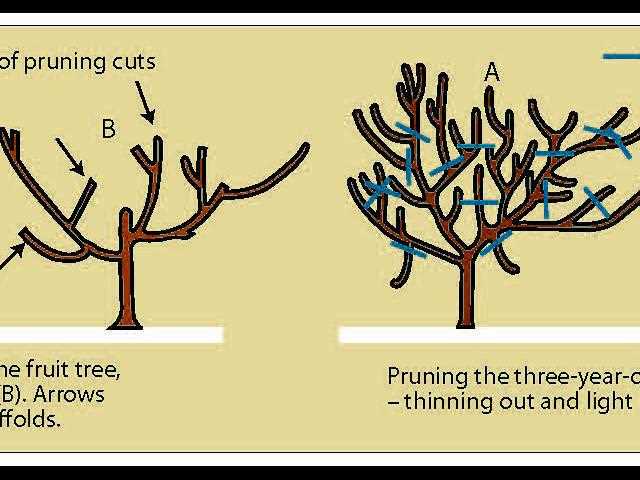
Pruning mature fruit trees is an essential task that helps maintain the health and productivity of the trees. Proper pruning techniques can improve the structure of the tree, promote better fruit production, and prevent potential disease and pest problems.
1. Timing
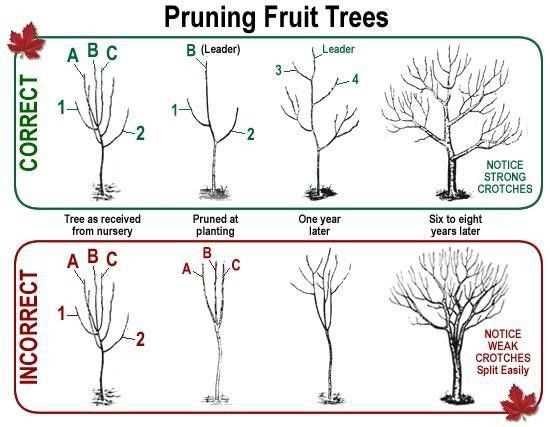
- Pruning mature fruit trees is typically done during late winter or early spring, before the tree starts to actively grow. This period allows the tree to heal and recover from the pruning cuts before the growing season begins.
- Avoid pruning during late fall or early winter as it may lead to excessive sap flow and hinder the healing process.
2. Tools
- Sharp pruning shears: Use clean, sharp pruning shears to make clean cuts and prevent tearing of the tree’s branches.
- Loppers: Loppers are useful for cutting thicker branches that are too large for pruning shears.
- Saw: A saw may be necessary for removing large branches or for making cuts on older, thicker wood.
- Protective gear: Wear gloves, safety glasses, and long-sleeved clothing to protect yourself from scratches and other hazards while pruning.
3. Techniques
- Remove dead or diseased wood: Start by removing any dead, damaged, or diseased wood from the tree. These branches can attract pests and diseases that can harm the overall health of the tree.
- Thin out the canopy: To promote better air circulation and sunlight penetration, selectively remove some of the interior branches to thin out the canopy. This helps prevent the development of fungal diseases and promotes better fruit ripening.
- Remove crossing or rubbing branches: Identify any branches that are crossing or rubbing against each other and remove one of them. These branches can cause wounds and provide entry points for diseases.
- Prune for shape and structure: Shape the tree by pruning back excessive growth and maintaining a balanced form. Avoid pruning more than one-third of the tree’s canopy in a single season to prevent excessive stress.
- Prune for fruit production: Prune to encourage fruit production by selectively removing branches that are not producing well or are overcrowding the tree. This allows the tree to focus its energy on developing quality fruit.
4. Aftercare
After pruning, it is essential to properly dispose of the pruned branches and clean up the area around the tree. This helps prevent the spread of diseases and pests. Additionally, consider applying a dormant oil spray or other recommended treatments to protect the tree against pest and disease infestations.
Regular pruning of mature fruit trees is crucial for their long-term health and productivity. By following proper pruning techniques and timing, you can ensure that your fruit trees will continue to thrive and provide bountiful harvests for years to come.
Pruning Diseased or Damaged Branches
Diseased or damaged branches can negatively impact the health and productivity of fruit trees. Pruning is an essential task to remove these branches and prevent further spread of diseases. Here are some tips and techniques for pruning diseased or damaged branches:
1. Identify the diseased or damaged branches
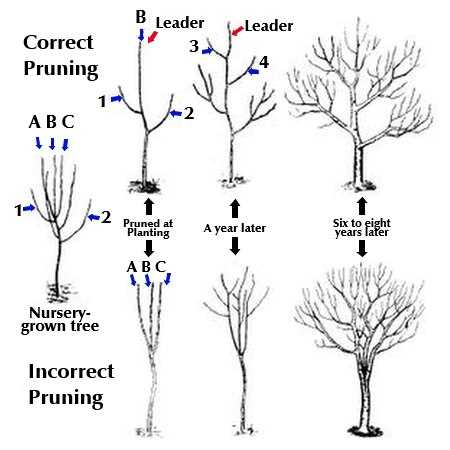
Inspect the fruit tree carefully to identify branches that show signs of disease or damage. Look for discoloration, lesions, cankers, or any other unusual growth or appearance.
2. Gather the necessary tools
Before pruning, make sure you have the right tools for the job. These may include pruning shears, loppers, a pruning saw, and a ladder if needed.
3. Remove the diseased or damaged branches
Using clean and sharp tools, carefully remove the identified branches. Make clean cuts just outside the branch collar, which is the swollen or raised area where the branch meets the trunk.
4. Dispose of the removed branches
To prevent the spread of diseases, it is crucial to properly dispose of the pruned branches. Bag them and dispose of them in the appropriate way, such as through municipal green waste collection or burning if allowed by local regulations.
5. Take preventive measures
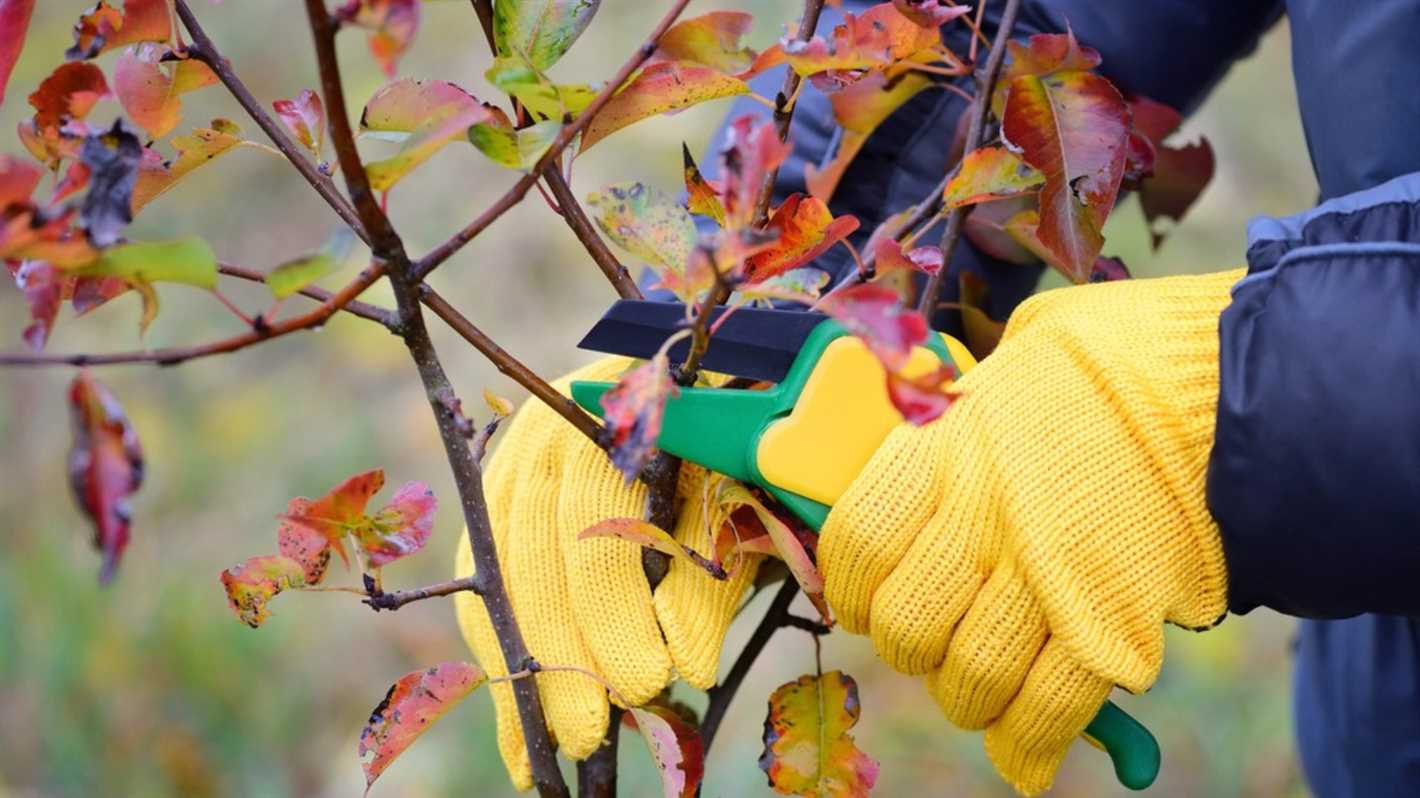
To minimize the risk of disease and damage in the future, it is important to take preventive measures. These may include regular inspections, proper tree care practices, and implementing disease management strategies.
6. Consider professional help
If you are unsure about the severity of the disease or the proper pruning techniques, it is recommended to seek professional help. Certified arborists or horticulturists can provide expert advice and assistance.
Remember, pruning diseased or damaged branches is a necessary task to maintain the health and productivity of fruit trees. By following these tips and techniques, you can ensure the optimal growth and vitality of your trees.
Aftercare and Maintenance
After pruning your fruit trees in the autumn, it is important to provide proper aftercare and maintenance to ensure their health and longevity. Here are some tips to help you take care of your trees after pruning:
1. Mulch
Apply a layer of organic mulch around the base of your fruit trees. Mulch helps retain moisture in the soil and prevents weed growth. It also acts as an insulating layer during winter, protecting the roots from extreme temperatures.
2. Watering
Proper watering is essential for the recovery of your fruit trees after pruning. Water the trees regularly, especially during dry spells, to keep the soil evenly moist. Avoid overwatering, as it can lead to root rot.
3. Fertilizing
After pruning, apply a balanced fertilizer to provide essential nutrients to the trees. Use a slow-release fertilizer to ensure a steady supply of nutrients over time. Follow the manufacturer’s instructions for the correct dosage and application method.
4. Pest and Disease Control
Monitor your fruit trees regularly for signs of pests and diseases. Pruning can create entry points for pests and diseases, so it is important to take preventive measures. Use organic pest control methods whenever possible to minimize the impact on the environment.
5. Training and Support
Inspect your fruit trees for any damaged or weak branches that may need additional support. Use tree stakes or ties to provide support and help the trees grow in the desired direction. Regularly check and adjust the support as the trees grow.
6. Regular Maintenance
Pruning is an ongoing process, so it is essential to continue with regular maintenance throughout the year. Remove any dead or diseased branches as soon as you notice them. Regularly inspect the trees for any signs of issues and taking necessary action promptly.
7. Record Keeping
Keep a record of the pruning activities you have performed, including dates, techniques used, and any observations. This record will help you track the progress of your fruit trees, identify patterns, and make informed decisions for future pruning sessions.
| Mulch | Apply organic mulch around the base of the trees. |
| Watering | Water the trees regularly to keep the soil moist. |
| Fertilizing | Apply a balanced slow-release fertilizer. |
| Pest and Disease Control | Monitor the trees for pests and diseases. |
| Training and Support | Provide support to damaged or weak branches. |
| Regular Maintenance | Remove dead or diseased branches regularly. |
| Record Keeping | Maintain a pruning record for future reference. |
Question-answer:
When is the best time to prune fruit trees in autumn?
The best time to prune fruit trees in autumn is after the leaves have fallen and the tree has entered dormancy. This is usually between late November and early March, depending on your climate.
Why is autumn pruning important for fruit trees?
Autumn pruning is important for fruit trees because it helps to shape the tree, remove dead or diseased branches, and promote healthy growth in the spring. It also allows the tree to focus its energy on developing a strong root system during the winter months.
What are some tips for pruning fruit trees in autumn?
Some tips for pruning fruit trees in autumn include using clean, sharp tools; removing any dead, damaged, or diseased branches; making clean cuts at the branch collar; and avoiding over-pruning, as this can stress the tree.
Can I prune my fruit trees in autumn if they are still producing fruit?
If your fruit trees are still producing fruit in autumn, it is generally best to wait until the tree has finished fruiting before pruning. Pruning during this time can disrupt the tree’s energy production and potentially reduce the next year’s fruit crop.
How long does it take for a pruned fruit tree to recover?
The recovery time for a pruned fruit tree can vary depending on various factors such as the type of tree, the extent of pruning, and growing conditions. Generally, it takes a fruit tree around 2 to 4 years to fully recover and resume normal fruit production after pruning.







